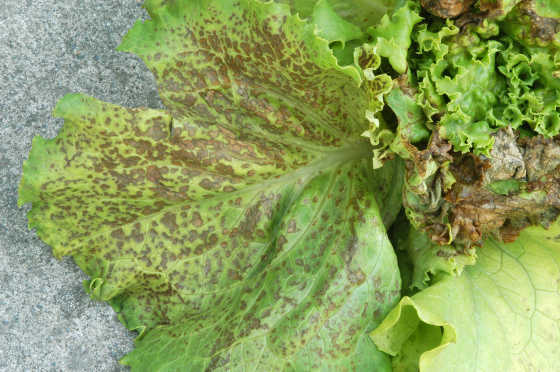The Unlikely Parallel Between Human And Plant Health
One of the notable national developments in the summer of 2014 was the unexpected occurrence of serious respiratory infections in children. Forty states in the country reported cases of youth who had trouble breathing, developed fevers, and required hospitalization. Health care professionals and researchers are scrambling to investigate and understand these outbreaks caused by the human pathogenic virus Enterovirus D68 (EV-D68).

If a virus outbreak takes place (such as in lettuce, pictured here with Impatiens necrotic spot virus), science-based investigations can help growers react to the problem. Photo credit: Steve Koike.
Of course, no one would say that sick crops are as important as, or on a par with, children suffering from EV-D68. However, what is notable is how the sciences of human medicine and plant pathology follow identical strategies when trying to investigate disease outbreaks.
Both sciences conduct research on the cause, incidence, distribution, and development of disease. Once these details are obtained, the most effective control measures can be implemented for both children and crops.
Identify The Pathogen
The first task was to conclusively identify the pathogen. Doctors and researchers had to determine if the children were infected with bacterial, viral, or other pathogens. Once they determined the outbreaks were due to an enterovirus, the task became more complicated. Which enterovirus? In most cases, local doctor’s offices and hospitals did not have the necessary tests that distinguished between common enteroviruses and the evidently more aggressive EV-D68. This limitation has hampered investigations of these outbreaks.
As a grower, you often face a similar challenge: Which pathogen is afflicting your crop? To ultimately devise the best management strategy, you must identify the plant pathogen. Is it a fungus, bacterium, or virus? By using a combination of field observations, lab isolations, serological assays, and tests based on DNA analysis, the microbes responsible for the disease can be identified.
As in human health cases, precision and accuracy are needed for plant diagnostics. For example, if a lettuce planting in California developed virus disease symptoms, which virus was responsible? Lab analyses will be needed to determine if the problem was caused by Impatiens necrotic spot virus (vectored by thrips) or by Lettuce necrotic stunt virus (a soilborne virus moved about in soil and water) since both viruses cause very similar symptoms.
Determine Rate of Infection
Medical researchers are trying to unravel the EV-D68 mystery by finding out exactly how many children have been infected and where such children are located. The rate of infection (the number of children reported sick per week) tells researchers something about the progression of the disease.
The whereabouts of the cases are also critical. Are cases randomly spread out among the various states? Does one state have many more reports than another? Are there clusters of cases, where reports tend to be aggregated around certain cities or urban centers?
Another critical question is whether the disease is increasing over time. For a grower, if a few plants show symptoms of a powdery mildew one week, and the following week a higher number of plants are affected, this will likely trigger a decision to apply fungicides or implement other appropriate measures.
Establish Outbreak Locations
It is important to determine if the outbreak is limited to one particular planting, or if multiple plantings and locations are involved. Is the plant disease being reported from multiple states, signaling an important regional epidemic? Are all cultivars of a particular crop involved, or are only certain varieties infected?
Investigators pay close attention to this cultivar question, as it could provide important information regarding a genetic variation of a pathogen. For example, if only certain spinach cultivars are developing severe downy mildew, this likely indicates that a particular mildew race is active in the area.
Growers might be able to escape infection on subsequent crops by planting spinach cultivars having resistance to that race. Answers to these and other questions help field consultants and Extension investigators make sense of the disease developments.
Determine Pathogen’s Origin
Even though the Centers for Disease Control and Prevention (CDC) are monitoring the EV-D68 situation, officials do not know where this current outbreak was initiated or why it occurred. While this virus is not a new virus, why is there this new development?
When plant disease outbreaks occur, agricultural professionals seek the same information. Where did the plant pathogenic fungus, bacterium, or virus come from? Was the pathogen already present in the field, or was the agent introduced on infested plant materials or contaminated field equipment?
For example, is there a trend or connection, such as the development of a disease on a particular cultivar that is planted on multiple ranches or in multiple counties or states, that suggests pathogen-infested seed lots?
Fashion A Response To Outbreaks
As the CDC collects lab and field information, and if EV-D68 cases continue to mount, medical professionals will devise a strategic response to combat the pathogen and protect our children and our communities. Plant pathologists, Extension agents, and crop consultants likewise compile field observations, collect diseased specimens, and conduct lab tests in order to understand crop disease outbreaks and implement appropriate disease control strategies.









